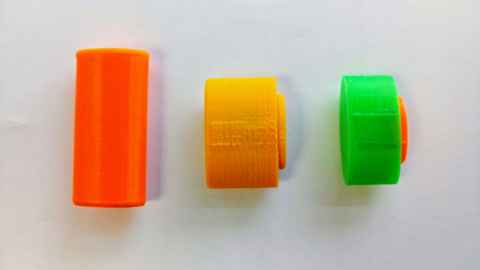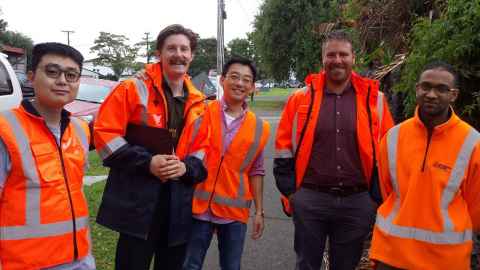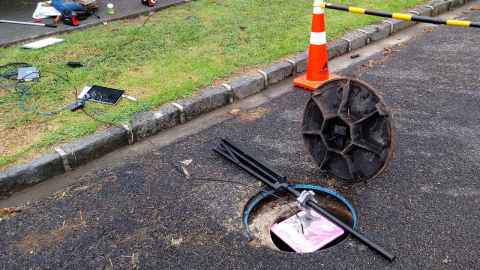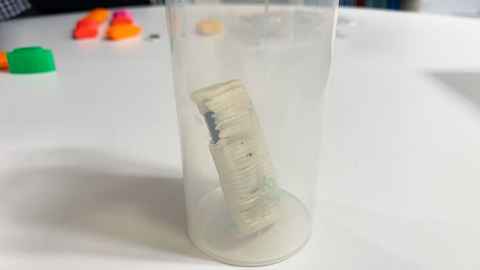Sensing our sewer systems
15 June 2021
Dr Wei-Qin Zhuang and his colleagues are discovering how to detect blocked sewage pipes using a similar technique as the technology we'd use to find our missing keys.

Cities in Aotearoa are no stranger to blocked wastewater pipes and sewage overflow. As our populations grow and produce more modern waste, our infrastructure is becoming less equipped to handle the increasing prominence of issues such as fatberg formation.
One solution is to monitor sewers before blockage and deterioration happens. At present, very few options exist, most of which are time-consuming and labour-intensive. To address this, Environmental Engineering lecturer Dr Wei-Qin Zhuang and his research team developed flushable Ultrahigh Frequency-Radio Frequency Identification (UHF-RFID) sensors.
These sensors are used to precisely detect sewer blockage and illicit connections in our drainage systems. Illicit and illegal connections can happen in several ways, with different environmentally-damaging outcomes. A sewer to stormwater illicit connection means that human waste containing pathogens will discharge without appropriate treatment into a receiving body, usually a beach or recreational body of water. Alternatively, an illicit connection from stormwater to sewer may significantly increase wastewater volumes in our treatment plants — stormwater will in this case need to be treated as if it is raw sewage, which incurs additional costs, labour and risks of overflow.
Their idea came from RFID technology’s ubiquity and flexibility. To Dr Zhuang, the benefits of RFIDs are that they’re “battery-free, a long lifespan, small size, and low cost”. Each UHF-RFID tag used in their study notably costs under NZD$2.
The technology also allows a high level of precision. “Each tag has its own unique serial number, as well as a chip that can store information such as street numbers. This helps us link tags to specific households”, Dr Zhuang adds.
To ensure that the sensors travel well, different materials were used to help the tags remain buoyant on wastewater surfaces. They settled on a 3D-printed PLA substrate that also increases the tags’ detection ranges by ensuring that their antennas are always aligned in the right position.
The results are rectangular-shaped pieces containing the sensors, each of them no larger than a cigarette lighter. According to Dr Zhuang, “the tags are designed to be small enough and flushable via a toilet bowl or directly released through a gully trap, so it’s a non-invasive method”.
Beyond the lab, the team conducted field trials with Auckland Council’s Healthy Waters department, Watercare, and Tonkin+Taylor. They flushed 101 tags into an Auckland sewer, with 95 being detected and registered in their RFID sensing system.

Dr Zhuang said that the team’s already detected and confirmed one illicit connection during their trials. They deduced this within the case of the six lost sensors, which they easily traced back to the tags’ “owners”. They then followed up by flushing down more sensors from a specific property, and found the sensor in stormwater as opposed to sewage, thus identifying it as an illegal sewage-to-stormwater connection.
For now, the benefits are palpable. Using this system involves minimal disruptions. In the case of upscaling, he suggests that hundreds of sensors can be read within seconds with a good quality RFID-detector. “We can set up a detector antenna in a sewer utility hole, and one in a stormwater utility hole”, Dr Zhuang suggests. “By identifying these illicit connections so easily and quickly, we prove that our method has high-throughput qualities. They can potentially efficiently re-map existing sewer networks that are now dated.”

Even with additional costs beyond the tags — antennas, RFID readers, computers, labour and the PLA shells — the trials led to an estimated cost of NZD$21 per property, with potential reductions if households flush the sensors themselves. In the meantime, they are also researching different materials for “pipe friendly” shells to ensure that they can degrade naturally in water.

The project team includes: Environmental Engineering PhD candidates Sundra Tatiparthi and Yashika de Costa, Environmental Engineering lecturer Dr Colin Whittaker, Mechanical Engineering lecturer Dr Ray Zhong, and two researchers from the University of Queensland: Dr Shihu Yu and Professor Zhiguo Yan. All are co-authors in their article detailing the test results in the recently-published Water Research journal, with more ongoing studies already proposed and in process. More recently, the research team has been asked by Auckland Council to conduct more tests to compare RFID sensing to other conventional methods.
“We’re very excited, partially because of the speed of our research so far — this went from an idea to successful field trials and real-life applications very quickly”, Dr Zhuang says.